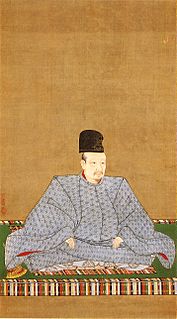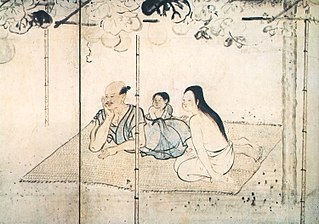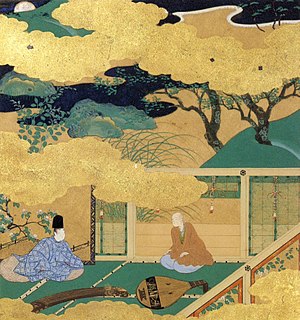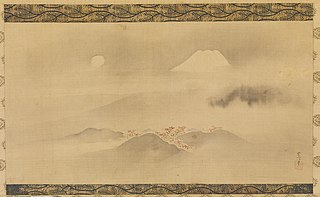 W
WKanō Tanshin (Morimasa) was a Japanese painter. He was the son of Kanō Tan'yū by his second wife, and led the Kajibashi branch of the Kanō school after 1674. Stylistically he was known for his Tosa-like, but more so his slight breaking away from the copycatting style of Kanō school masters that became a large critical argument in the rebellious anti-Kanō school movement of late Edo period. Parallel anti-Kanō school artist Hanabusa Itchō commended Tanshin on having "rare talent" derived from his ability to apply nature as a model. Itchō asserts Tanshin became a true artist by capturing the spirit of the bamboo to convey an idea.
 W
WKanō Einō was a Japanese painter of the Kyō-ganō sub-school of the Kanō school of painting. He became head of the Kyō-ganō upon the death of his father Kanō Sansetsu, and his grandfather was the Kyō-ganō's founder Kanō Sanraku. Einō compiled the Honchō Gashi, the earliest serious art-historical work in Japan.
 W
WKanō Naganobu was a Japanese painter of the Kanō school.
 W
WKanō Naonobu was a Japanese painter of the Kanō school of painting during the early Edo period. He was the younger brother of Kanō Tan'yū, with whom he completed a number of prominent commissions for the Tokugawa shogunate. His style differed somewhat from Tan'yū's in his bold use of negative space and his mastery of ink wash painting. Naonobu also used the art name Jitekisai (自適斎).
 W
WKanō Takanobu was a Japanese painter of the Kanō school of painting during the Azuchi–Momoyama period (1573–1615). He was the father of Kanō Tan'yū, one of the most prominent painters of the school.
 W
WKanō Yasunobu was a Japanese painter of the Kanō school of painting during the Edo period. He was the third son of Kanō Takanobu, who had been head of the school, and succeeded Kanō Sadanobu as head of the Kyoto branch in 1623 until he joined his brothers in. Yasunobu was the youngest brother of Kanō Tan'yū, one of the most prominent painters of the Kanō school. His best remembered work is the Gadō Yōketsu, a Kanō school history and training manual. He also worked under the art names Eishin (永真) and Bokushinsai (牧心斎).
 W
WKanō Naizen was a part of the Japanese family of painters, the Kanō school. He was the middle son of school's head Kanō Eitoku, younger brother to the Kano school heir Kanō Mitsunobu, older brother to Kanō Takanobu, and adopted brother to the famed Kanō school painter Kanō Sanraku. Naizen primarily worked with his fathers and brothers in the head Kanō workshop in Kyoto to restore many imperial buildings, Buddhist temples, and Shinto shrines that were destroyed during the Kamakura period and the Genpei Wars. In 1610–15 Naizen moved to Edo, the new administration capital, at the behest of the recently ascendent Tokugawa shogunate, Tokugawa Ieyasu.
 W
WKanō Sansetsu was a Japanese painter also known as Kanō Heishiro. He was born in Hizen Province, Kyūshū, and died in Kyoto.
 W
WKanō Tan'yū was one of the foremost Japanese painters of the Kanō school. His original given name was Morinobu; he was the eldest son of Kanō Takanobu and grandson of Kanō Eitoku. Many of the most famous and widely known Kanō works today are by Tan'yū.
 W
WKusumi Morikage was a Japanese painter of the Edo period. He came from Kaga Province, the centre of the lands of the Maeda clan. He fell afoul of his teacher, Kanō Tan'yū, and became the Maeda clan's official painter. His sympathy for farmers and the poor people of the Edo period is reflected in his works.
 W
WTosa Mitsunori was an illustrator from the Tosa school of painting during the Azuchi–Momoyama period and the early Edo period. He was a son of Tosa Mitsuyoshi and the father of Tosa Mitsuoki. Although having moved to Sakai in his youth, he sometimes presented painted fanss to the Sentō Imperial Palace, but he did not receive a position at the court. About the age of 52, in his later years, he returned to Kyoto with his eldest son, Mitsuoki.
 W
WKanō Tsunenobu (狩野常信) (1636–1713) was a Japanese painter of the Kanō school. He first studied under his father, Kanō Naonobu, and then his uncle, Kanō Tan'yū, after his father's death. He became a master painter and succeed his uncle Tan'yū as head of the Kanō school in 1674. It is believed many works attributed to Tan'yū might actually be Tsunenobu, but it is difficult to know since they often worked on larger pieces together.